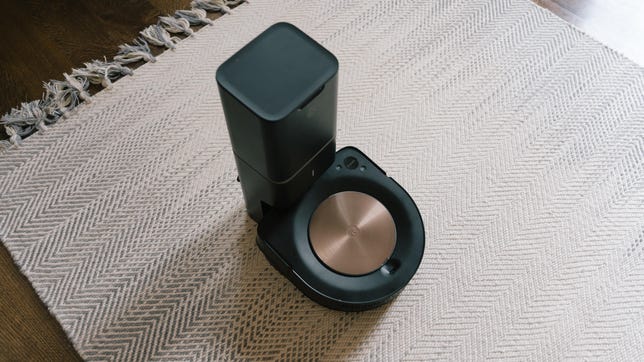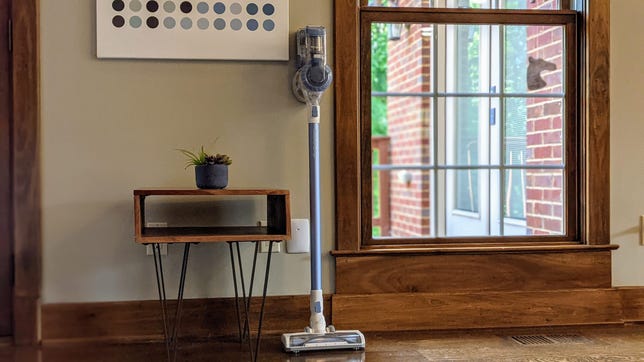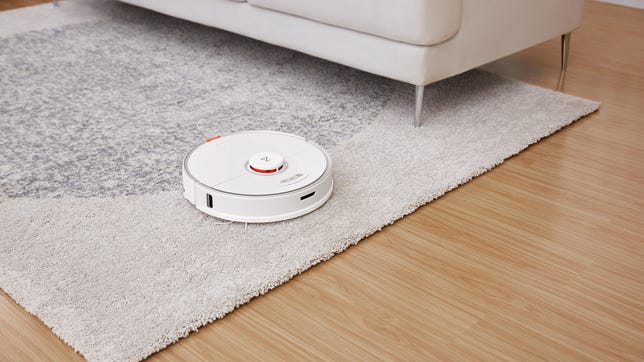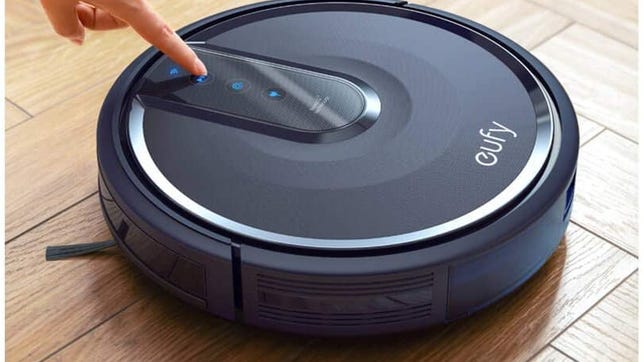
In this article:
I’m always looking for an easier way to keep my house clean, especially when it comes to vacuuming. Here’s a tip: Having the right vacuum cleaner can make all the difference. Robot vacuums are almost effortless and take care of the the hard work for you. But if you prefer to do the vacuuming yourself, cordless vacuums are a lightweight alternative to lugging around a heavy, old-fashioned vacuum between outlets.
If you’re looking for the absolute easiest option out there, the best vacuum cleaner for you may be a robot vacuum cleaner, which will pick up dust and debris around the house. The most advanced models navigate autonomously, avoiding obstacles by using cameras, lasers and other sensor components. Some robot vacs can even empty their own dustbins without human help. Talk about taking the hassle out of good housekeeping. Many feel that the best vacuum cleaner is one they don’t have to use at all. Why lift a finger if you don’t have to?
Read more: How to Clean Your Living Room in 10 Minutes or Less
You don’t need to go broke, either. There are plenty of great robotic and cordless vacuums at various prices. Whether you’re seeking a top-of-the-line cleaner, a midrange model or a basic machine, the best vacuum cleaner for you is on the list below.
We did many rounds of testing to bring you the best cordless vacuums and the best robot vacuums. Check out each of those articles for thorough reviews on each subcategory. In this list, we’ve compiled our top picks for overall best vacuum cleaner into one handy location. Your convenience is of the utmost importance to us here at CNET. We will continue to keep all of these best vacuum cleaner lists up-to-date as new models and new features come out, and we test new vacuum cleaner categories.
Best vacuum cleaners
Tyler Lizenby/CNET
Battery Life/Runtime
60 min
Weight
6.8 pounds
Bin Capacity
0.77 liters
Anti-Allergy Filter (HEPA)
Yes
Vacuum Type
Cordless stick
As the newest cordless vacuum in Dyson’s lineup, the V15 Detect is one impressive machine. It’s the best performing stick vacuum of its kind that we’ve ever tested. The cordless vac excels at removing pet hair from multiple floor surfaces. It also pulled 88.4% of test sand we placed on midpile carpeting. Also impressive, the V15 vacuum cleaner pulled 95.3% of sand particles we dropped onto low-pile carpeting.
The vacuum’s “Laser Slim Fluffy” cleaner head is unique as well. It’s designed specifically for hard flooring, and shines a green laser out onto the floor ahead as you clean. Its purpose is to highlight dust and other small bits of debris otherwise hard to spot with the naked eye. The system does work, and we observed plenty of dirt on the hard floor we’d normally miss. One drawback, though, is that the laser isn’t visible under strong indoor lighting or sunlight.
We also like the readout on the back of the vacuum. This report lists the ratio of dirt collected by particle size. The Dyson vacuum machine’s battery is easy to remove too, and its dustbin is a snap to empty.
You’re receiving price alerts for Dyson V15 Detect Cordless Vacuum
Tyler Lizenby/CNET
Battery Life/Runtime
120 min
Weight
8.2 pounds
Bin Capacity
0.38 liters
Anti-Allergy Filter (HEPA)
Yes
Vacuum Type
Robot
Priced at $1,000 (currently on sale for $799) the Roomba S9 Plus is the most expensive product on this list. Still, you do get a lot of bang for all those bucks. This iRobot Roomba vacuum delivers powerful suction and superb dirt and dust removal.
On hardwood floors this Roomba picked up an average of 93% of our test sand, the highest amount in our test group, but it struggled a bit cleaning sand from low-pile carpeting and area rugs, earning a low average dust and sand pickup of 28%.
That said, the Roomba robot vac removed an average 71% of sand from our medium pile carpet while vacuuming. Again, this is the best result that we saw on this specific test. The robotic vacuum also cleaned up more dog hair, pet dander and allergens than any vacuum in this test group, and the bot navigates and maps multiple rooms and floors. iRobot has also updated its app to let you designate “keep-out zones” that you want the S9 Plus to avoid when cleaning. The app also lets you use voice commands to immediately clean a room using Alexa or Google Voice Assistant.
The robot flew through our test room in a short average time of 25 minutes, too. You can link the S9 Plus to the Roomba app and your home Wi-Fi as well. Best of all is the Roomba S9 Plus’ CleanBase docking station. The dock both charges the robot’s battery and empties its dustbin automatically, making cleaning even easier and keeping you from worrying about battery life. Now that’s convenient.
You’re receiving price alerts for iRobot Roomba s9 Plus
Brian Bennett/CNET
Battery Life/Runtime
40 min
Weight
5.5 lbs
Bin Capacity
0.6 liters
Anti-Allergy Filter (HEPA)
Yes
Vacuum Type
Cordless stick
As the second-best performer in our current cordless vacuum test group, the Tineco A11 Hero stick vacuum represents an outstanding deal. So much so that it has officially bumped the Shark Rocket Pet Pro Cordless out of our top pick for best midrange cordless vacuum. With an average 72.5% sand pick-up from midpile carpeting, and 82.5% sand removal from low-pile carpet, the Hero bagless vacuum cleaner performs better. This cordless stick vac also costs less than the Shark, a fact that’s hard to overlook.
The A11 Hero cordless vac tackled pet hair without too much trouble as well. Barely a trace of the material remained after the machine vacuumed midpile carpeting and hardwood floors. The Hero left some strands visible when traveling across our low-pile test carpet. Midpile carpeting usually causes vacuums more problems. Tineco A11 Hero lightweight vacuum has got a high-performance battery that delivers up to 40 minutes of uninterrupted run time.
The design of the Hero isn’t too shabby either. Its dustbin is almost as easy to empty as the Rocket Pet Pro. The bin’s release valve is tricky to engage compared with Shark’s. That said, its battery pack is removable. There’s also a handy trigger lock lever to keep the vacuum running without constant finger pressure. This portable handheld vacuum comes with a power brush, mini power brush, two-in-one dusting brush, and a crevice tool for versatile cleaning.
You’re receiving price alerts for Tineco A11 Hero
Roborock
Battery Life/Runtime
180 min
Weight
10.4 lbs
Bin Capacity
0.47 liters
Anti-Allergy Filter (HEPA)
Yes
Vacuum Type
Robot
A new challenger to this space, robot vacuum maker Roborock earns our current award for best midrange robot vacuum. It was almost as good at removing sand from hardwood floors (92.8%) as the Roomba S9 Plus (93%). The S7 did pretty well on medium-pile (50.4%) and low-pile carpets too (64.2%).
And while the Roborock S7 doesn’t tackle pet hair as effectively as the S9 Plus, it did better than many other machines we’ve tested. The S7 also had no trouble navigating through our robot vacuum test room either. It completed this task in an average of just 16 minutes. Some vacuums need up to 90 minutes to perform the same operation.
We also like how the Roborock S7 comes with a mop attachment. It enables the robot to both scrub hard surfaces and vacuum carpets and rugs simultaneously.
You’re receiving price alerts for Roborock S7 Robot Vacuum
Chris Monroe/CNET
Battery Life/Runtime
35 min
Weight
3.3 pounds
Bin Capacity
1.3 liters
Anti-Allergy Filter (HEPA)
Yes
Vacuum Type
Cordless stick
Moosoo may not be a household name. Even so, the Moosoo M X6 cordless bagless vacuum packs a respectable punch, considering its low price. Despite costing much less than competing cordless vacuum cleaner options, the M X6 was the fourth-best performer in our test group of eight models.
The stick vac picked up 99% (on average) of our test sand from hardwood. On low-pile carpet, that figure sank to 41.3%. The M X6 fared better across thicker midpile carpet though, earning a higher sand pickup average of 52.2%.
Black rice, our large particle test soil, was a breeze for the Moosoo vacuum. It managed pickup averages above 90% on hardwood, low-pile and midpile carpet (95.4, 96.8 and 94%, respectively).
Don’t buy the Moosoo M X6, though, if you’re a pet owner. Cons are that at least some visible dander remained after vacuuming, no matter the test surface. The brush roll tends to wrap strands of hair around itself as well.
If you want cordless vacuuming on a tight budget, however, consider the Moosoo M X6. This cordless stick vacuum cleaner just might fit the bill, and for much less cash.
Amazon
Battery Life/Runtime
100 min
Weight
5.7 pounds
Bin Capacity
0.6 liters
Anti-Allergy Filter (HEPA)
No
Vacuum Type
Robot
Everybody loves an underdog which is why the RoboVac 25C makes us smile. This robot vacuum model doesn’t just have a comparatively low price. It demonstrated performance more in line with what we expect from pricey machines. It pulled 78.9% of test sand from hardwood floors, no much less than the Roborock S7.
The RoboVac 25C’s showing on low-pile (53.5%) and medium-pile (52.2%) wasn’t bad either. It even managed to leave just one tuft of pet hair from hardwood floors. Still, it pulled less hair from low-pile carpets. And left even more hair on medium-pile carpets.
You’ll have to set aside lots of cleaning time for this robot too. It needed an average of 91 minutes to cover our test room.
How we test vacuum cleaners
Our method for evaluating robot vacuums is straightforward, yet grueling. There are two types of tests we run. The first trial is to figure out how well a robot covers the floor while it’s cleaning. We built an industry-standard testing room as specified by the International Electrotechnical Commission, just for this purpose. The IEC is an international standards body responsible for managing robot vacuum testing procedures, among other things, for vacuum manufacturers.
Obstacles in our test room mimic what robot vacuums run into in the real world.
Tyler Lizenby/CNET
Inside this room are objects designed to simulate typical obstacles a robot vac encounters for navigation as it cleans. These obstacles include wall edges, table and chair legs, couches and other furniture, and so on, plus bare tile and hardwood floors, as well as carpet. We mount LED lights to the top of each vacuum cleaner. The dimensions of the lights correspond to the measured nozzle width of each particular robot vacuum we test.
Read more: How to Clean Your Kitchen in Under 15 Minutes
As robots move through the room while cleaning, a camera overhead captures a long-exposure image of the entire room in low light. That photo will then have a light trail, created by the LEDs, that shows the exact areas where the robot traveled (and its nozzle position) during its runtime. We can also see areas of the floor the vacuum may have missed or gotten stuck. You can see the navigation results of all the robot vacuums in our test group in the gallery below.
Some robot vacuums have a better sense of direction than others
The second type of test reveals exactly how much physical debris a vacuum is able to pick up off of the floor. To mimic dirt of small particle size, we use a mixture of play-sand and landscaping sand. For bigger particle soil, we use grains of uncooked black rice. Robots then run in straight line mode across three types of flooring (low-pile carpet, medium-pile carpet and hardwood bare floors).
We test robot vacuums on three types of floor surfaces.
Tyler Lizenby/CNET
We control for the specific nozzle width of each vacuum, too. We constructed an adjustable tool to soil our test floors. It lets us lay down a strip of precise area of soil to match the nozzle dimensions for every robot. The mass of soil isn’t chosen at random either. We measure a proportional amount that’s related to the flooring material, type of debris, plus each vacuum’s nozzle width.
Our custom-built tool lets us match soil area to a robot vacuum’s nozzle width.
Tyler Lizenby/CNET
We conduct three cleaning runs (at minimum) on each floor type. We also perform cleaning tests with sand and rice separately. That comes to at least 18 tests per robot vac. We weigh the robot’s dust bin both before and after each run. From there we can calculate the percentage of debris pickup for every cleaning run and the average amount of soil a machine manages to remove. Additionally we run anecdotal (visual) pet hair tests for each robot, on all three floor types.
Read more: How to Clean Your Bathroom in 10 Minutes or Less
We run robot vacuums in a straight line during the debris pickup tests.
Tyler Lizenby/CNET
Our rice-based, medium-size particle test didn’t show enough differentiation between each cleaner, which says they can all handle larger particles without trouble. For fur removal for pet owners, we judged anecdotally.
How we test cordless vacuums
Putting cordless vacuums through their paces isn’t as complicated as testing a robot vacuum cleaner, but it still takes lots of time and careful effort to find the best cordless vacuum. We run each vacuum in a straight line across three different surfaces (hardwood, low-pile carpet, midpile carpet). On all three test beds, the test area is the same length (30.25 inches).
We run tests in a straight line across all three floor types.
Brian Bennett/CNET
Just like in robot tests, the width of the test bed is proportional to the vacuum’s nozzle width. We measure this width ourselves. We also use nozzle width, plus the flooring type, to calculate the soil density for each test, per International Electrotechnical Commission guidelines. The IEC is an international standards body responsible for managing vacuum testing procedures, among other things, for vacuum manufacturers.
We use the same soil types here as well; sand, rice, and pet hair. We perform three runs (at minimum) on each floor type. We also test suction power with sand and rice separately. That comes to at least 18 tests per vacuum. We weigh the vacuum’s dust bin both before and after each run.
From there we can calculate the percentage of dirt and debris pickup for every run and the average amount of soil a vacuum manages to remove. Additionally, we run anecdotal (visual) pet hair tests for each vacuum, on all three floor types to help us select the best cordless vacuum.






